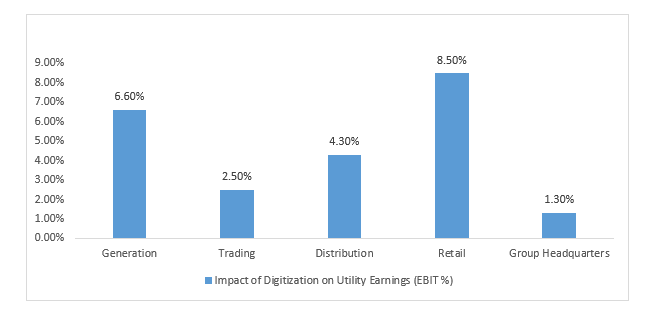Внедрение цифровых технологий в коммунальном хозяйстве для повышения эффективности и устойчивости
Цифровая трансформация - это интеграция цифровых технологий во все аспекты бизнеса с целью повышения эффективности и производительности. Внедрение таких передовых технологий в коммунальном секторе, как анализ сетей, интеллектуальные счетчики и распределенные энергетические ресурсы. Это помогает улучшить взаимодействие с клиентами, повысить эффективность, оптимизировать операции и стимулировать новые бизнес-модели. Искусственный интеллект используется для анализа больших наборов данных и получения бизнес-аналитики.
Ожидается, что к 2028 году объем рынка цифровых энергетических предприятий составит около 239,38 млрд долларов США, по сравнению с 239,38 млрд долларов США при среднегодовом темпе роста 23,4%
Примеры использования
Мониторинг состояния трубопроводов – стартап Leakster разработал способ мониторинга состояния трубопроводов без необходимости отключения водоснабжения. На трубу устанавливается АКТИВНЫЙ датчик, и данные отправляются в облако. Алгоритмы на основе искусственного интеллекта выявляют утечки, колебания давления, засоры и скорость. Это позволяет коммунальным предприятиям принимать обоснованные решения по управлению активами и техническому обслуживанию, экономя средства на масштабном и дорогостоящем ремонте.
Wind360 – Weather company, компания IBM, предоставляет точные данные о погоде. Это инструмент, который предоставляет данные о скорости и направлении ветра в режиме реального времени для любой точки мира, позволяя коммунальным компаниям понимать погоду и оптимизировать свою деятельность и многое другое.
Движущие факторы цифровизации в коммунальном хозяйстве
Увеличение капиталовложений в проекты возобновляемой энергетики наряду с растущим спросом на энергию из-за усиления индустриализации ускорило рост цифровизации коммунальных компаний, поскольку для этого требуются более совершенные системы прогнозирования погоды, эффективные системы мониторинга и анализа данных для снижения энергопотребления и предоставления решений для истощения необходимых ископаемых видов топлива.
Общий эффект цифровизации привел к увеличению прибыли коммунальных предприятий на 23,2%, а приведенный ниже график показывает влияние цифровизации на области ее улучшения.

Преимущества цифровизации в коммунальном хозяйстве
Расширенные возможности для клиентов – Цифровая трансформация помогла оцифровать процессы, используя данные для персонализации взаимодействия. Теперь коммунальные предприятия могут предоставлять своим клиентам в целом более качественное обслуживание. Цифровые каналы позволяют клиентам получать доступ к информации и совершать транзакции, что приводит к удовлетворению и лояльности клиентов.
Улучшенное управление данными – Это позволяет нам внедрять новые технологии, которые могут оптимизировать операции и сделать возможным анализ данных, что приводит к общему улучшению управления данными.
Повышение операционной эффективности – Цифровая трансформация может помочь повысить эффективность, снизить затраты и повысить общий уровень обслуживания клиентов. Например, автоматизация процессов считывания показаний счетчиков и выставления счетов помогла коммунальным предприятиям сократить расходы на бухгалтерский учет и административные расходы.
Улучшенное принятие решений – Внедрение цифровых технологий обеспечило большую ясность в возможности видеть данные и действовать на их основе способами, которые ранее были невозможны. Это помогает повысить точность решений и общую эффективность.
Повышенная безопасность – Цифровая трансформация повысила безопасность в коммунальном хозяйстве, предоставив такие возможности, как мониторинг данных в режиме реального времени, позволяющий коммунальным предприятиям выявлять подозрительную активность и решать проблемы. Ее способность повышать безопасность в коммунальном хозяйстве имеет широкий спектр применения.
Повышенная устойчивость – Автоматизация энергоемких процессов, улучшение управления активами и оцифровка взаимодействия с клиентами могут помочь снизить потребление энергии. Данные и аналитика могут оптимизировать управление активами и повысить операционную эффективность.
Основные тенденции цифровой трансформации в коммунальном хозяйстве
Периферийные вычисления – Тип вычислений, при котором данные могут обрабатываться локально. Это важно для предоставления данных и аналитики в режиме реального времени.
Цифровые двойники – Это цифровая копия физической системы. Он собирает данные с физического объекта и использует эти данные для создания реалистичных моделей поведения объекта. Его можно использовать для тестирования новых конструкций и оптимизации производительности, оказывая помощь в сокращении времени простоя, повышении эффективности и улучшении управления рисками, связанными с активами.
Заключение
Рост цифровизации привел к росту ожиданий потребителей; коммунальным компаниям приходится адаптироваться к этим изменениям. Цифровизация является ключом к улучшению обслуживания потребителей, повышению эффективности операций, снижению затрат и удовлетворению потребностей в обеспечении устойчивости, предъявляемых компаниями и странами. Определенные проблемы во внедрении этих технологий связаны с высокими эксплуатационными расходами, связанными с заменой существующей инфраструктуры. Тем не менее, преимущества перевешивают проблемы, и цифровизация коммунальных услуг неизбежна в преобразовании каждого аспекта отрасли.
Автор: Абхишек Саини
